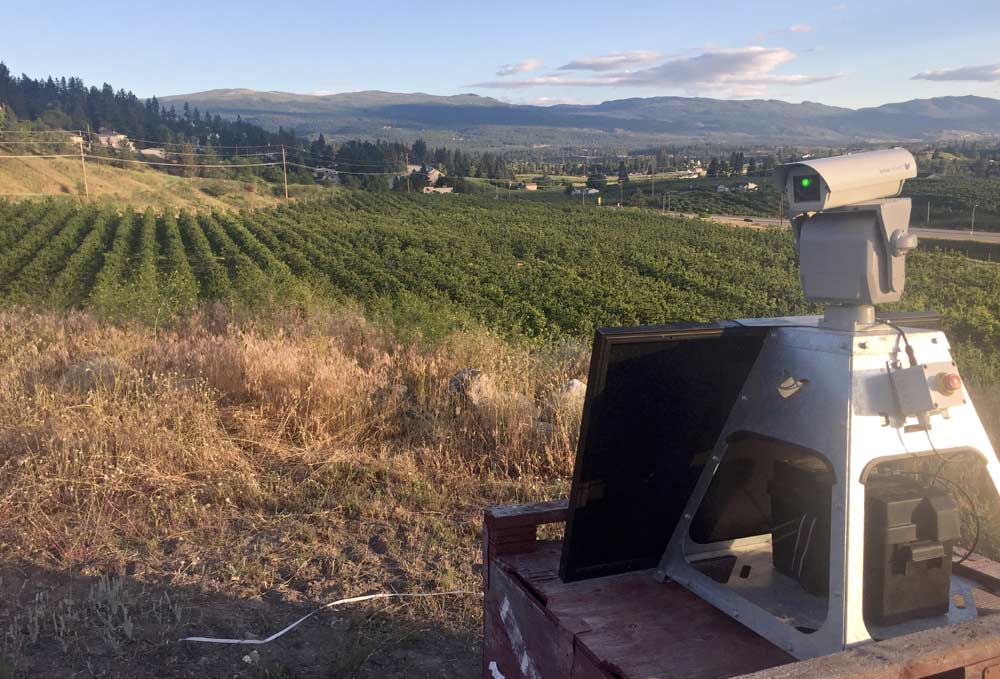
Coral Beach has seen success with laser control of birds at its orchards in Coldstream, British Columbia. (Courtesy Coral Beach Farms Ltd.)
British Columbia fruit growers are finally getting a handle on one of their most persistent winged pests. Years after an areawide program helped orchardists control codling moth, a similar approach is helping to combat starlings.
“It was pretty devastating the damage that starlings did in the valley,” said John Carsorso, who farms 8 acres of table grapes, 10 acres of wine grapes and 30 acres of tree fruits in Kelowna. “You dealt with massive swarms, in the harvest season especially. … It was like a war zone here, with scare guns, bird squawkers, shotguns.”
But because the devices merely scattered the birds, who learned that the noise wasn’t fatal, populations didn’t decline. The birds kept feeding on the fruit, reproducing, and wreaking havoc on local crops.
Any fruit that wasn’t devoured was subject to nips, pecks and bites rendering it unsaleable. “We lost tons of grapes every year,” he said.
Originally released in New York’s Central Park in the 1890s, the humble starling has spread across North America and become a significant predator of fruit crops. While other species flock to orchards looking for a free meal, including robins, cowbirds, magpies and crows, starlings are by far the most numerous. Biologists estimate the population in North America at close to 200 million — enough to rank it of “least concern” in B.C. and exempt from protection under the B.C. Wildlife Act.
A trapping program launched in 2003 under the auspices of the BC Grape Growers’ Association, whose members are most vulnerable to starlings, has helped cut the local population significantly. The trapped birds are euthanized and became food for birds at a raptor rehabilitation center.
Originally funded largely by donations from growers, the program became a partnership between industry and local governments in 2006. Growers and the three regional districts covering the Okanagan and Similkameen valleys, as well as the municipality of West Kelowna, fund the program’s annual budget of $105,000 Canadian (approximately $84,525 U.S.).
Since 2003, it has eliminated more than 800,000 starlings, reducing the pressure on crops and growers.
“People are seeing less birds, they’re spending less money on bird predation techniques,” said Tyrion Miskell, program administrator with the BCGGA. “We see a lot less netting, there’s a lot less propane cannons.”
Casorso agreed. “We still get some smaller flocks of starlings,” he said. “It’s impossible to completely eradicate them, but we’re talking flocks of maybe 200 to 500 versus 3,000 to 5,000 to 8,000. It’s just a fraction of what it used to be.”

M-traps are one tool British Columbia growers use to manage starling populations. (Courtesy EBB Environmental Consulting Inc.)
There are now plans to target overwintering and breeding populations in the North Okanagan, which would establish even more effective population control by nipping the problem in the nest.
The trapping program’s success is allowing for new, less-intrusive bird control tools such as lasers.
Vernon cherry grower Coral Beach Farms Ltd. credits the areawide control program with reducing starling pressure in its orchards, but horticulture manager Gayle Krahn said other species remain troublesome.
Coral Beach has long used a noisemaker system and experimented with falconry in 2016, but Krahn said lasers have been the most effective against birds and least annoying to workers and neighbors.
Residents of Coldstream, just east of Vernon, have been battling Coral Beach’s use of blowers, sprayers and helicopters. The noise prompted a complaint to B.C.’s Farm Industry Review Board, which handles such matters under the province’s Right-to-Farm legislation.
Cherry pickers, meanwhile, hated the noisemakers intended to scare away birds.
“The lasers, no one really notices them,” Krahn said. “It’s not an issue. It’s safe. We have it going when there’re pickers in the orchard, and there’s never been a problem.”
The birds stay away, avoiding being caught under the laser beams.
“The agri-lasers have actually been fairly effective,” Krahn said. “The crows in particular would sit outside of where the laser was running.”
The green beam sweeps across the 88-acre orchard in two minutes, tracing three different patterns that undulate with the topography of the orchard. Set-up takes less than 15 minutes.
“Coral Beach has two farms that are about 3 kilometers (a little less than 2 miles) away from each other,” Krahn said. Lasers were used at one farm and a noisemaker system was used at the other. “And lasers won, hands-down,” Krahn said.
Casorso said the softer control measures have been a boon for the industry and the community, but he sees no reason for complacence. Growers need to keep supporting the starling control program while adopting the softer control measures to prevent starlings from returning in greater numbers.
“As you keep getting new growers, new people coming in, they’re reaping the benefits of the prior years of work, so they don’t have a memory or a history of the disaster it once was,” he said. “If people forget that, we’ll end up back where we were and it will cost millions.” •
—by Peter Mitham






Leave A Comment